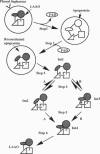Abstract
The reconstitutable apoprotein of Crotalus adamanteus L-amino acid oxidase was prepared using hydrophobic interaction chromatography. After reconstitution with flavin adenine dinucleotide, the resulting protein was inactive, with a perturbed conformation of the flavin binding site. Subsequently, a series of cosolvent-dependent compact intermediates was identified. The nearly complete activation of the reconstituted apoprotein and the restoration of its native flavin binding site was achieved in the presence of 50% glycerol. We provide evidence that in addition to a merely stabilizing effect of glycerol on native proteins, glycerol can also have a restorative effect on their compact equilibrium intermediates, and we suggest the hydrophobic effect as a dominating force in this in vitro-assisted restorative process.
Full text
PDF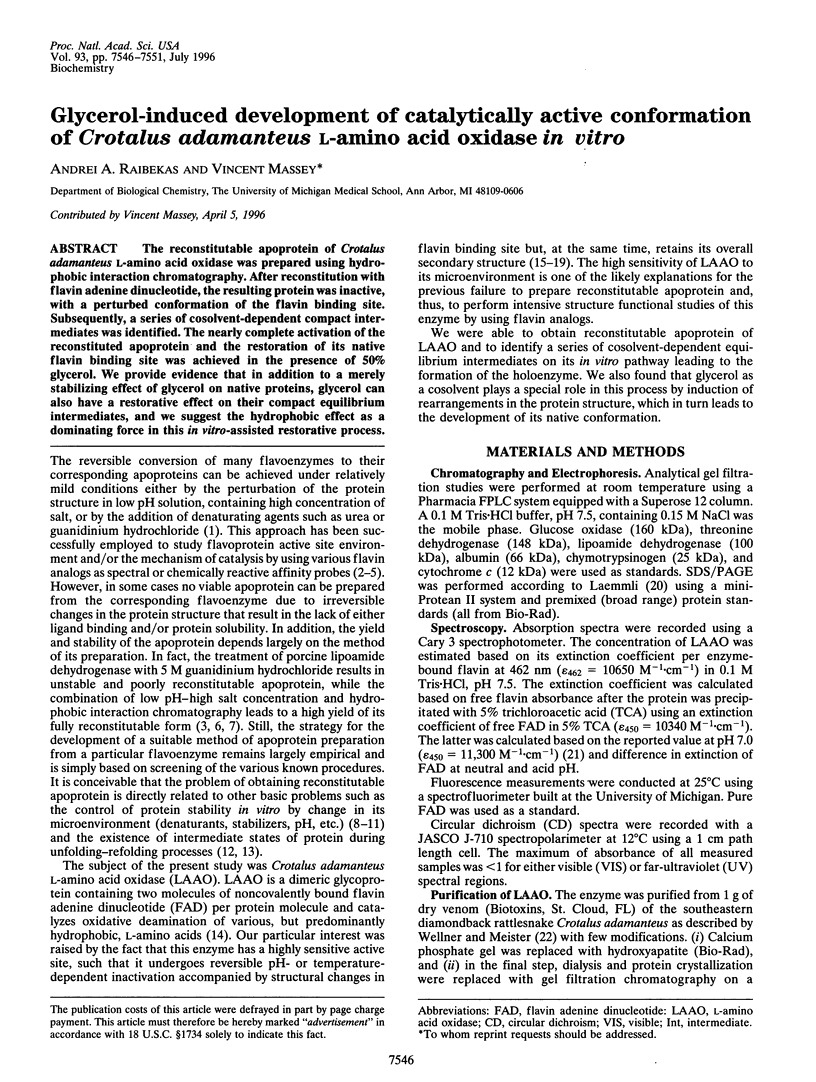
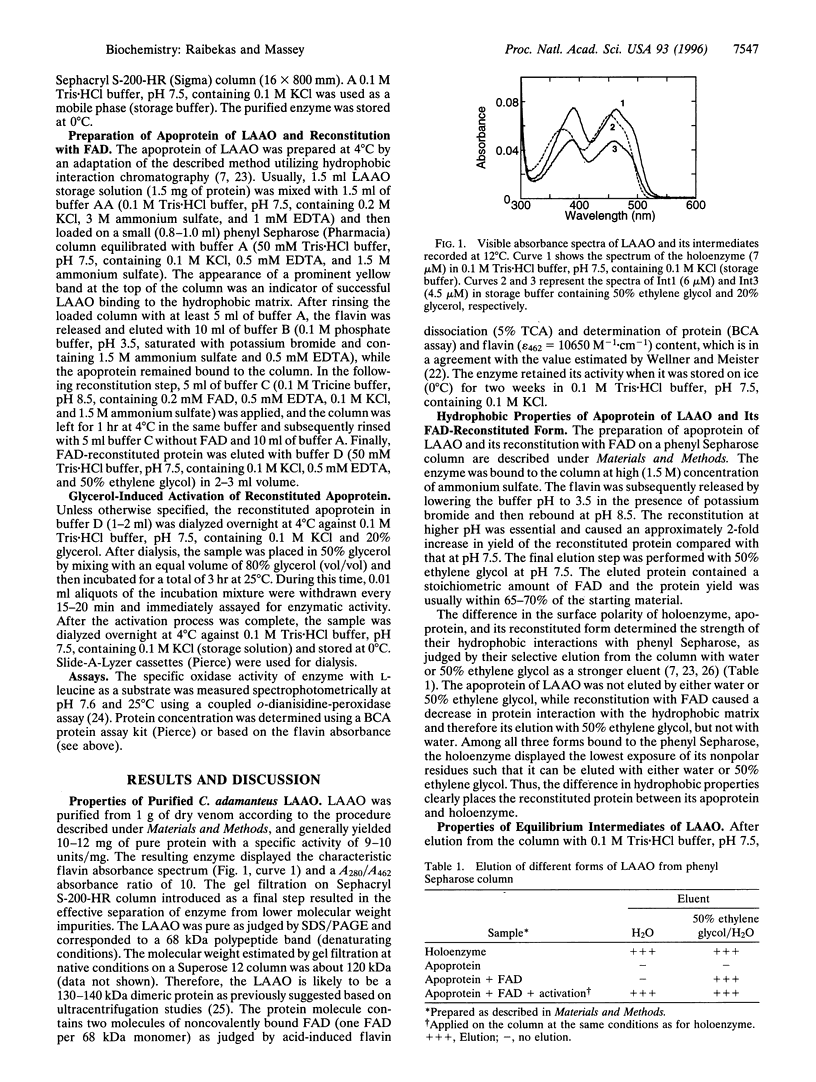
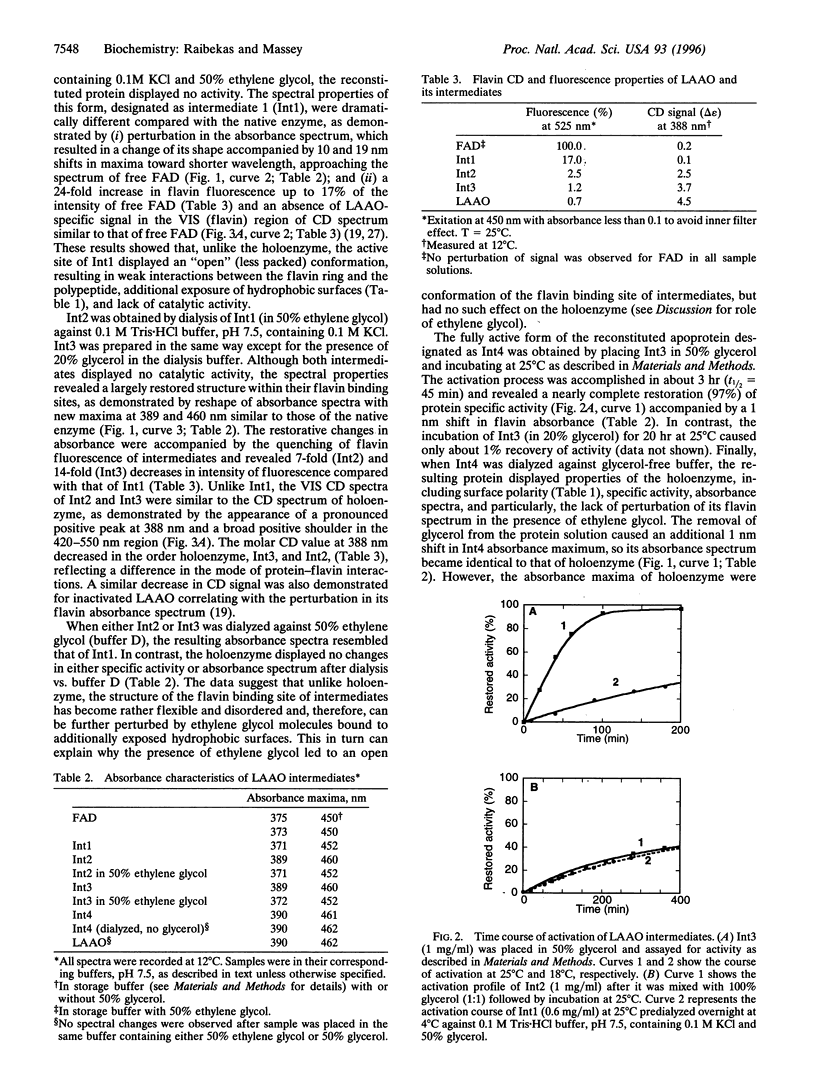
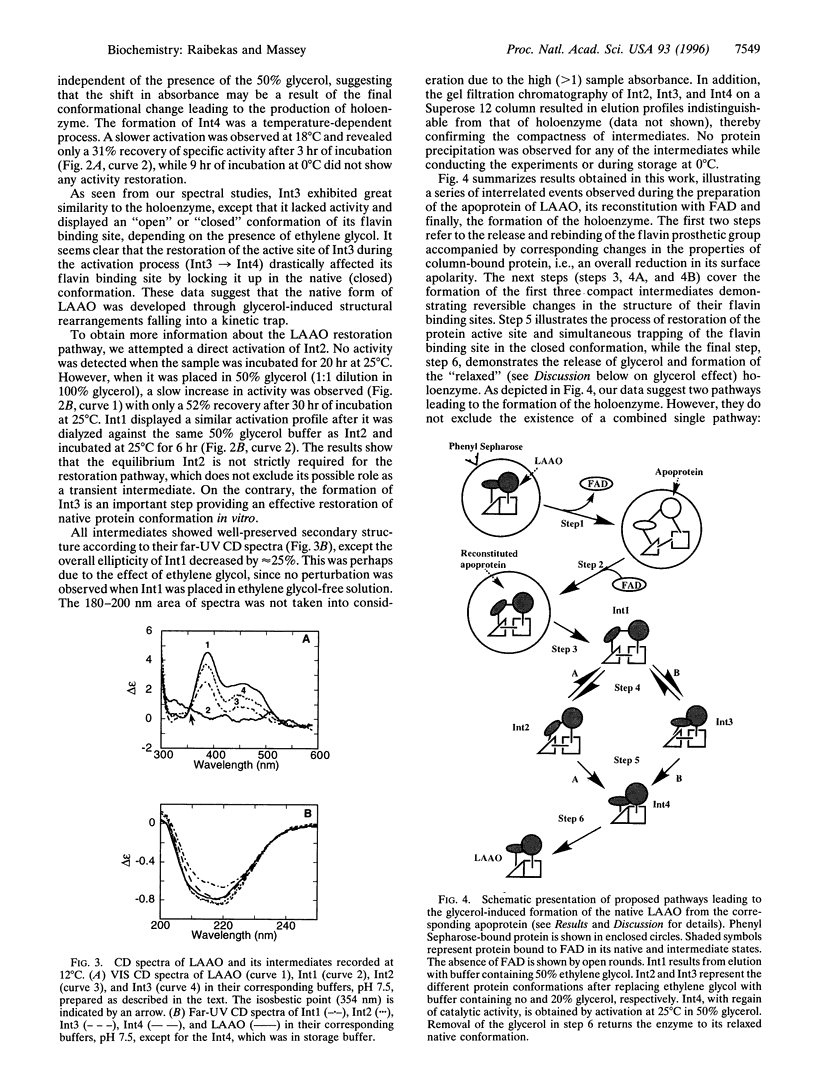
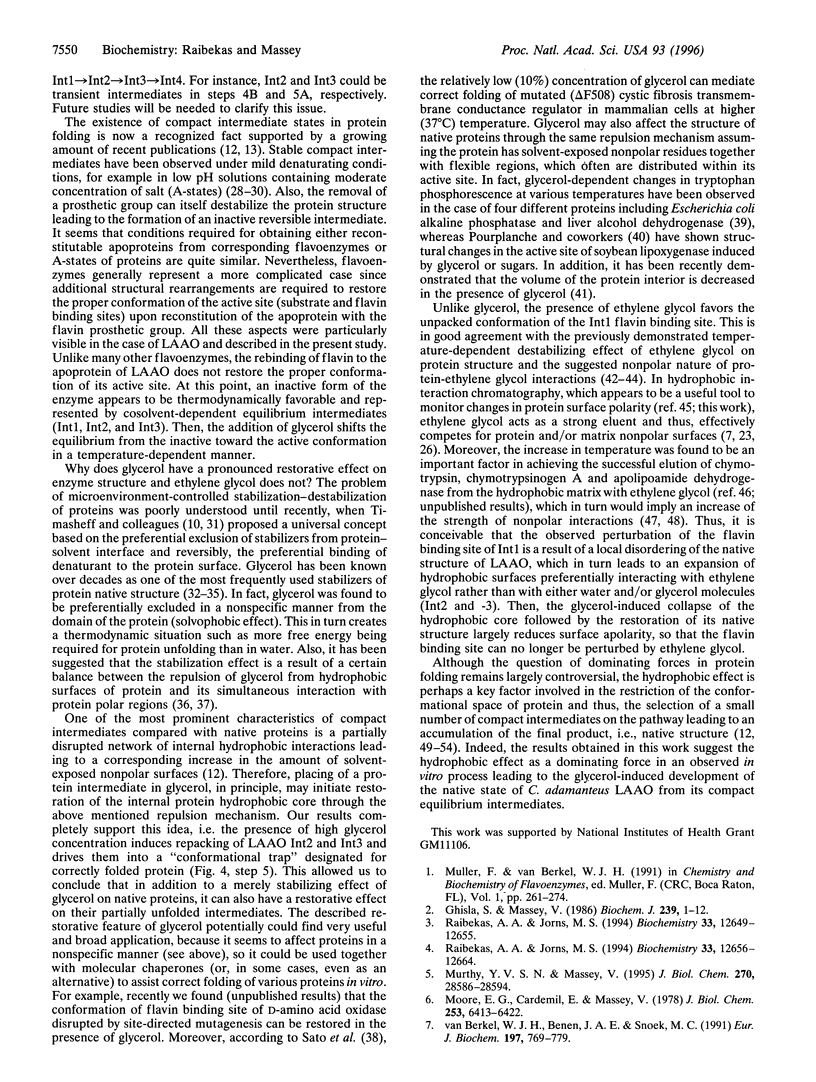
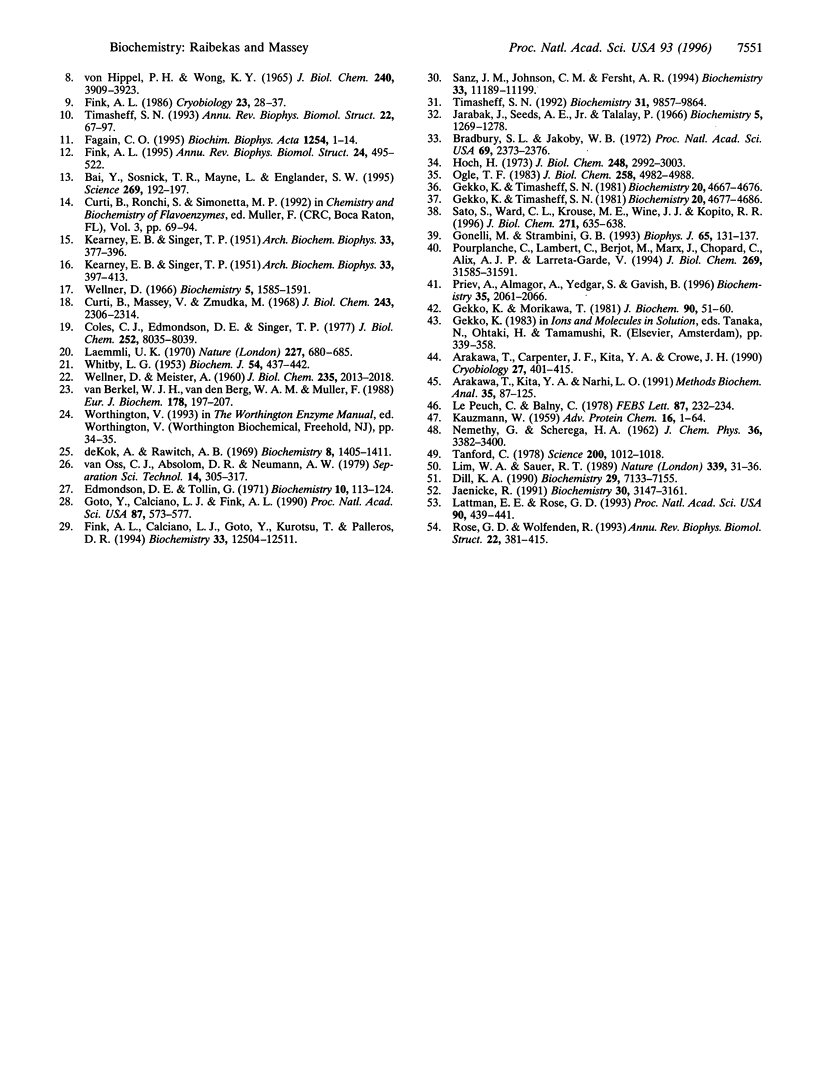
Images in this article
Selected References
These references are in PubMed. This may not be the complete list of references from this article.
- Arakawa T., Kita Y. A., Narhi L. O. Protein-ligand interaction as a method to study surface properties of proteins. Methods Biochem Anal. 1991;35:87–125. doi: 10.1002/9780470110560.ch2. [DOI] [PubMed] [Google Scholar]
- Bai Y., Sosnick T. R., Mayne L., Englander S. W. Protein folding intermediates: native-state hydrogen exchange. Science. 1995 Jul 14;269(5221):192–197. doi: 10.1126/science.7618079. [DOI] [PMC free article] [PubMed] [Google Scholar]
- Bradbury S. L., Jakoby W. B. Glycerol as an enzyme-stabilizing agent: effects on aldehyde dehydrogenase. Proc Natl Acad Sci U S A. 1972 Sep;69(9):2373–2376. doi: 10.1073/pnas.69.9.2373. [DOI] [PMC free article] [PubMed] [Google Scholar]
- Coles C. J., Edmondson D. E., Singer T. P. Reversible inactivation of L-amino acid oxidase. Properties of the three conformational forms. J Biol Chem. 1977 Nov 25;252(22):8035–8039. [PubMed] [Google Scholar]
- Curti B., Massey V., Zmudka M. Inactivation of snake venom L-amino acid oxidase by freezing. J Biol Chem. 1968 May 10;243(9):2306–2314. [PubMed] [Google Scholar]
- Dill K. A. Dominant forces in protein folding. Biochemistry. 1990 Aug 7;29(31):7133–7155. doi: 10.1021/bi00483a001. [DOI] [PubMed] [Google Scholar]
- Edmondson D. E., Tollin G. Circular dichroism studies of the flavin chromophore and of the relation between redox properties and flavin environment in oxidases and dehydrogenases. Biochemistry. 1971 Jan 5;10(1):113–124. doi: 10.1021/bi00777a018. [DOI] [PubMed] [Google Scholar]
- Fink A. L., Calciano L. J., Goto Y., Kurotsu T., Palleros D. R. Classification of acid denaturation of proteins: intermediates and unfolded states. Biochemistry. 1994 Oct 18;33(41):12504–12511. doi: 10.1021/bi00207a018. [DOI] [PubMed] [Google Scholar]
- Fink A. L. Compact intermediate states in protein folding. Annu Rev Biophys Biomol Struct. 1995;24:495–522. doi: 10.1146/annurev.bb.24.060195.002431. [DOI] [PubMed] [Google Scholar]
- Fink A. L. Effects of cryoprotectants on enzyme structure. Cryobiology. 1986 Feb;23(1):28–37. doi: 10.1016/0011-2240(86)90015-5. [DOI] [PubMed] [Google Scholar]
- Fágáin C. O. Understanding and increasing protein stability. Biochim Biophys Acta. 1995 Sep 27;1252(1):1–14. doi: 10.1016/0167-4838(95)00133-f. [DOI] [PubMed] [Google Scholar]
- Gekko K., Morikawa T. Thermodynamics of polyol-induced thermal stabilization of chymotrypsinogen. J Biochem. 1981 Jul;90(1):51–60. doi: 10.1093/oxfordjournals.jbchem.a133469. [DOI] [PubMed] [Google Scholar]
- Gekko K., Timasheff S. N. Mechanism of protein stabilization by glycerol: preferential hydration in glycerol-water mixtures. Biochemistry. 1981 Aug 4;20(16):4667–4676. doi: 10.1021/bi00519a023. [DOI] [PubMed] [Google Scholar]
- Gekko K., Timasheff S. N. Thermodynamic and kinetic examination of protein stabilization by glycerol. Biochemistry. 1981 Aug 4;20(16):4677–4686. doi: 10.1021/bi00519a024. [DOI] [PubMed] [Google Scholar]
- Ghisla S., Massey V. New flavins for old: artificial flavins as active site probes of flavoproteins. Biochem J. 1986 Oct 1;239(1):1–12. doi: 10.1042/bj2390001. [DOI] [PMC free article] [PubMed] [Google Scholar]
- Gonnelli M., Strambini G. B. Glycerol effects on protein flexibility: a tryptophan phosphorescence study. Biophys J. 1993 Jul;65(1):131–137. doi: 10.1016/S0006-3495(93)81069-5. [DOI] [PMC free article] [PubMed] [Google Scholar]
- Goto Y., Calciano L. J., Fink A. L. Acid-induced folding of proteins. Proc Natl Acad Sci U S A. 1990 Jan;87(2):573–577. doi: 10.1073/pnas.87.2.573. [DOI] [PMC free article] [PubMed] [Google Scholar]
- Hoch S. O. Tryptophan synthetase from Bacillus subtilis. Purification and characterization of the component. J Biol Chem. 1973 May 10;248(9):2999–3003. [PubMed] [Google Scholar]
- Jaenicke R. Protein folding: local structures, domains, subunits, and assemblies. Biochemistry. 1991 Apr 2;30(13):3147–3161. doi: 10.1021/bi00227a001. [DOI] [PubMed] [Google Scholar]
- KAUZMANN W. Some factors in the interpretation of protein denaturation. Adv Protein Chem. 1959;14:1–63. doi: 10.1016/s0065-3233(08)60608-7. [DOI] [PubMed] [Google Scholar]
- KEARNEY E. B., SINGER T. P. The L-amino acid oxidases of snake venom. III. Reversible inactivation of L-amino acid oxidases. Arch Biochem Biophys. 1951 Oct;33(3):377–396. doi: 10.1016/0003-9861(51)90125-7. [DOI] [PubMed] [Google Scholar]
- KEARNEY E. B., SINGER T. P. The L-amino acid oxidases of snake venom. IV. The effect of anions on the reversible inactivation. Arch Biochem Biophys. 1951 Oct;33(3):397–413. doi: 10.1016/0003-9861(51)90126-9. [DOI] [PubMed] [Google Scholar]
- Laemmli U. K. Cleavage of structural proteins during the assembly of the head of bacteriophage T4. Nature. 1970 Aug 15;227(5259):680–685. doi: 10.1038/227680a0. [DOI] [PubMed] [Google Scholar]
- Lattman E. E., Rose G. D. Protein folding--what's the question? Proc Natl Acad Sci U S A. 1993 Jan 15;90(2):439–441. doi: 10.1073/pnas.90.2.439. [DOI] [PMC free article] [PubMed] [Google Scholar]
- Lim W. A., Sauer R. T. Alternative packing arrangements in the hydrophobic core of lambda repressor. Nature. 1989 May 4;339(6219):31–36. doi: 10.1038/339031a0. [DOI] [PubMed] [Google Scholar]
- Moore E. G., Cardemil E., Massey V. Production of a covalent flavin linkage in lipoamide dehydrogenase. Reaction with 8-Cl-FAD. J Biol Chem. 1978 Sep 25;253(18):6413–6422. [PubMed] [Google Scholar]
- Murthy Y. V., Massey V. Chemical modification of the N-10 ribityl side chain of flavins. Effects on properties of flavoprotein disulfide oxidoreductases. J Biol Chem. 1995 Dec 1;270(48):28586–28594. doi: 10.1074/jbc.270.48.28586. [DOI] [PubMed] [Google Scholar]
- Ogle T. F. Action of glycerol and sodium molybdate in stabilization of the progesterone receptor from rat trophoblast. J Biol Chem. 1983 Apr 25;258(8):4982–4988. [PubMed] [Google Scholar]
- Pourplanche C., Lambert C., Berjot M., Marx J., Chopard C., Alix A. J., Larreta-Garde V. Conformational changes of lipoxygenase (LOX) in modified environments. Contribution to the variation in specificity of soybean LOX type 1. J Biol Chem. 1994 Dec 16;269(50):31585–31591. [PubMed] [Google Scholar]
- Priev A., Almagor A., Yedgar S., Gavish B. Glycerol decreases the volume and compressibility of protein interior. Biochemistry. 1996 Feb 20;35(7):2061–2066. doi: 10.1021/bi951842r. [DOI] [PubMed] [Google Scholar]
- Raibekas A. A., Jorns M. S. Affinity probing of flavin binding sites. 1. Covalent attachment of 8-(methylsulfonyl)FAD to pig heart lipoamide dehydrogenase. Biochemistry. 1994 Oct 25;33(42):12649–12655. doi: 10.1021/bi00208a016. [DOI] [PubMed] [Google Scholar]
- Raibekas A. A., Jorns M. S. Affinity probing of flavin binding sites. 2. Identification of a reactive cysteine in the flavin domain of Escherichia coli DNA photolyase. Biochemistry. 1994 Oct 25;33(42):12656–12664. doi: 10.1021/bi00208a017. [DOI] [PubMed] [Google Scholar]
- Rose G. D., Wolfenden R. Hydrogen bonding, hydrophobicity, packing, and protein folding. Annu Rev Biophys Biomol Struct. 1993;22:381–415. doi: 10.1146/annurev.bb.22.060193.002121. [DOI] [PubMed] [Google Scholar]
- Sanz J. M., Johnson C. M., Fersht A. R. The A-state of barnase. Biochemistry. 1994 Sep 20;33(37):11189–11199. doi: 10.1021/bi00203a015. [DOI] [PubMed] [Google Scholar]
- Sato S., Ward C. L., Krouse M. E., Wine J. J., Kopito R. R. Glycerol reverses the misfolding phenotype of the most common cystic fibrosis mutation. J Biol Chem. 1996 Jan 12;271(2):635–638. doi: 10.1074/jbc.271.2.635. [DOI] [PubMed] [Google Scholar]
- Tanford C. The hydrophobic effect and the organization of living matter. Science. 1978 Jun 2;200(4345):1012–1018. doi: 10.1126/science.653353. [DOI] [PubMed] [Google Scholar]
- Timasheff S. N. The control of protein stability and association by weak interactions with water: how do solvents affect these processes? Annu Rev Biophys Biomol Struct. 1993;22:67–97. doi: 10.1146/annurev.bb.22.060193.000435. [DOI] [PubMed] [Google Scholar]
- Timasheff S. N. Water as ligand: preferential binding and exclusion of denaturants in protein unfolding. Biochemistry. 1992 Oct 20;31(41):9857–9864. doi: 10.1021/bi00156a001. [DOI] [PubMed] [Google Scholar]
- Van Berkel W. J., Van den Berg W. A., Müller F. Large-scale preparation and reconstitution of apo-flavoproteins with special reference to butyryl-CoA dehydrogenase from Megasphaera elsdenii. Hydrophobic-interaction chromatography. Eur J Biochem. 1988 Dec 1;178(1):197–207. doi: 10.1111/j.1432-1033.1988.tb14444.x. [DOI] [PubMed] [Google Scholar]
- Von Hippel P. H., Wong K. Y. On the conformational stability of globular proteins. The effects of various electrolytes and nonelectrolytes on the thermal ribonuclease transition. J Biol Chem. 1965 Oct;240(10):3909–3923. [PubMed] [Google Scholar]
- WELLNER D., MEISTER A. Crystalline L-amino acid oxidase of Crotalus adamanteus. J Biol Chem. 1960 Jul;235:2013–2018. [PubMed] [Google Scholar]
- WHITBY L. G. A new method for preparing flavin-adenine dinucleotide. Biochem J. 1953 Jun;54(3):437–442. doi: 10.1042/bj0540437. [DOI] [PMC free article] [PubMed] [Google Scholar]
- Wellner D. Evidence for conformational changes in L-amino acid oxidase associated with reversible inactivation. Biochemistry. 1966 May;5(5):1585–1591. doi: 10.1021/bi00869a019. [DOI] [PubMed] [Google Scholar]
- deKok A., Rawitch A. B. Studies on L-amino acid oxidase. II. Dissociation and characterization of its subunits. Biochemistry. 1969 Apr;8(4):1405–1411. doi: 10.1021/bi00832a015. [DOI] [PubMed] [Google Scholar]
- van Berkel W. J., Benen J. A., Snoek M. C. On the FAD-induced dimerization of apo-lipoamide dehydrogenase from Azotobacter vinelandii and Pseudomonas fluorescens. Kinetics of reconstitution. Eur J Biochem. 1991 May 8;197(3):769–779. doi: 10.1111/j.1432-1033.1991.tb15970.x. [DOI] [PubMed] [Google Scholar]



